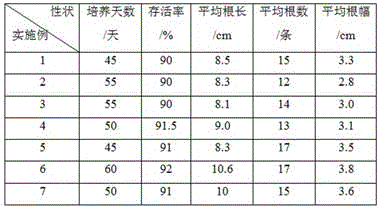Ancient tea tree breeding method
A technology of tea trees and branches, applied in the field of propagation, can solve the problems of inability to solve the problems of ancient tea tree propagation in Dachagou, unsuitable for large-scale cultivation, and low quality characteristics of plants, so as to facilitate later transplanting, fast propagation speed, and easy Promoted app performance
- Summary
- Abstract
- Description
- Claims
- Application Information
AI Technical Summary
Problems solved by technology
Method used
Image
Examples
Embodiment 1
[0022] A kind of propagation method of ancient tea tree, comprises the following steps:
[0023] (1) In March 2014, the branches of ancient tea trees in Dachagou, Xinyang were topped, and 50% gibberellin was sprayed on the branches for 3 days;
[0024] (2) Collect semi-lignified branches, cut them into 1000 short branches with leaves of 3 cm, leave axillary buds, and the upper and lower cuts are smooth. The solution is dipped in the cut of the lower end of the branch, then the cuttings are placed in a soilless substrate and cultivated for 20 days in a natural environment. The soilless substrate includes the following raw materials in percentage by weight: peat 62%, vermiculite 35% and superphosphate 3% , the content of organic matter in the matrix is 15%, the content of total nitrogen is 0.3%, the content of total phosphorus is 0.2%, the content of total potassium is 0.5%, and the pH value of the matrix is 5.0;
[0025] (3) Transplant the branches of step (2) into a cultu...
Embodiment 2
[0028] A kind of propagation method of ancient tea tree, comprises the following steps:
[0029] (1) In March 2014, the branches of ancient tea trees in Dachagou, Xinyang were topped, and 50% gibberellin was sprayed on the branches for 2 days;
[0030] (2) Collect semi-lignified branches and cut them into 1,000 short branches with leaves of 4 cm. The upper and lower cuts are smooth, and the cuts at the lower ends of the branches are parallel to the growth direction of the leaves. Cuttage is then cultivated in a soilless substrate for 25 days in a natural environment. The soilless substrate includes the raw materials of the following weight percentages: peat 65%, vermiculite 32% and superphosphate 3%, and the organic matter content in the substrate is 17%, total nitrogen content 0.35%, total phosphorus content 0.28%, total potassium content 0.6%, matrix pH value 4.5;
[0031] (3) Step (2) branch cuttings are housed in the cultivation bag of nutrient soil, and described nutrien...
Embodiment 3
[0034] A kind of propagation method of ancient tea tree, comprises the following steps:
[0035] (1) In September 2014, the branches of ancient tea trees in Dachagou, Xinyang were topped, and 50% gibberellin was sprayed on the branches for 3 days;
[0036] (2) Collect semi-lignified branches and cut them into 1000 short branches with leaves of 5cm. Then the cuttings were placed in the soilless substrate and cultivated in the natural environment for 30 days. The soilless substrate included the raw materials in the following percentages by weight: peat 70%, vermiculite 27% and superphosphate 3%, and the organic matter content in the substrate was 18%, total nitrogen content 0.4%, total phosphorus content 0.35%, total potassium content 0.65%, matrix pH value 6.0;
[0037] (3) Transplant the branches of step (2) into a culture bag equipped with nutrient soil. The nutrient soil includes the following raw materials in weight percentage: 55% garden soil, 22% yellow heart soil, 10% n...
PUM
 Login to View More
Login to View More Abstract
Description
Claims
Application Information
 Login to View More
Login to View More - R&D
- Intellectual Property
- Life Sciences
- Materials
- Tech Scout
- Unparalleled Data Quality
- Higher Quality Content
- 60% Fewer Hallucinations
Browse by: Latest US Patents, China's latest patents, Technical Efficacy Thesaurus, Application Domain, Technology Topic, Popular Technical Reports.
© 2025 PatSnap. All rights reserved.Legal|Privacy policy|Modern Slavery Act Transparency Statement|Sitemap|About US| Contact US: help@patsnap.com

